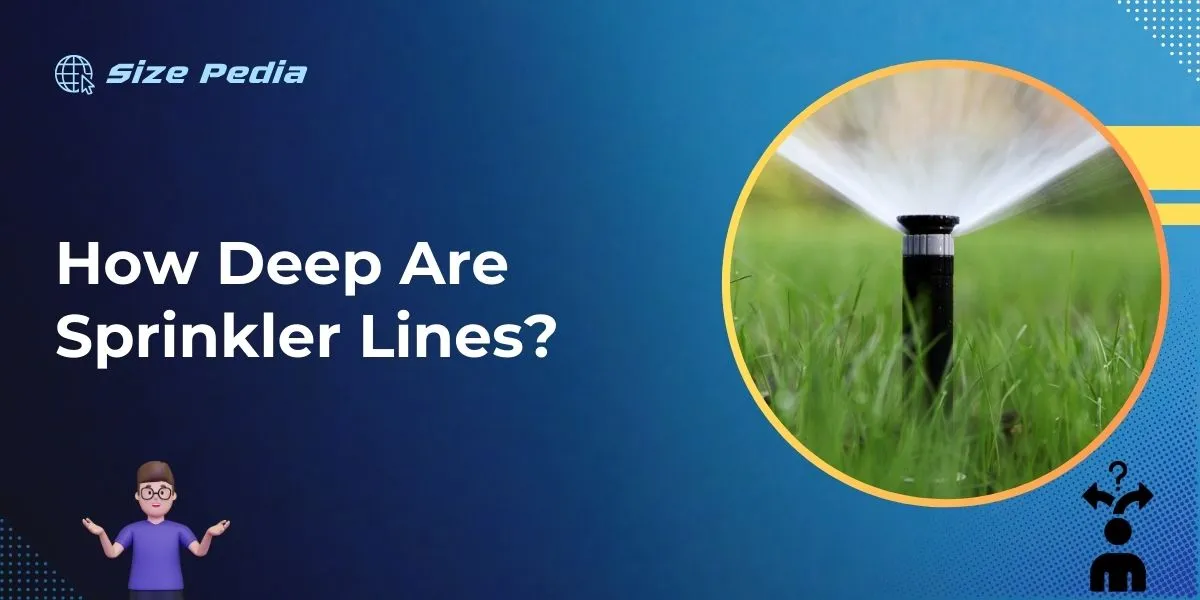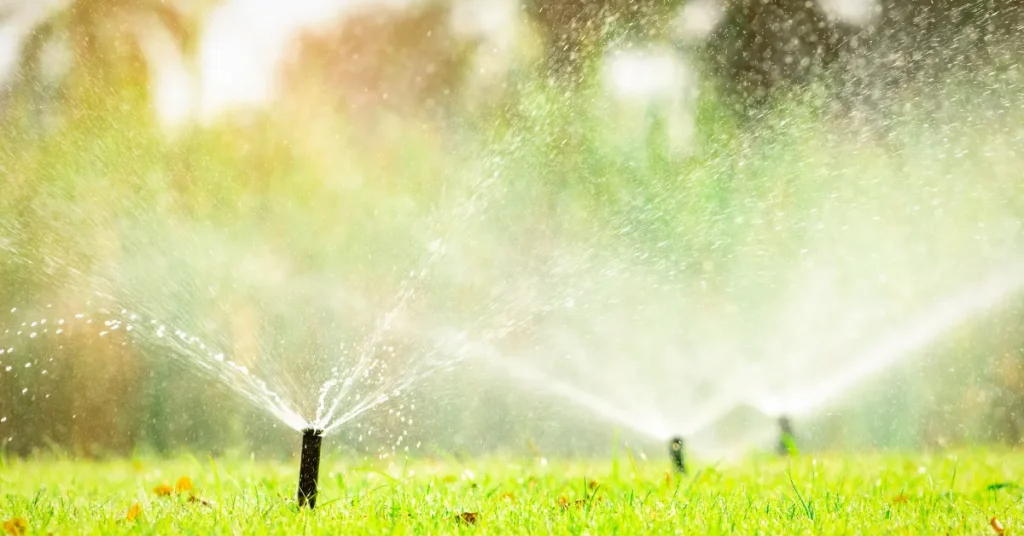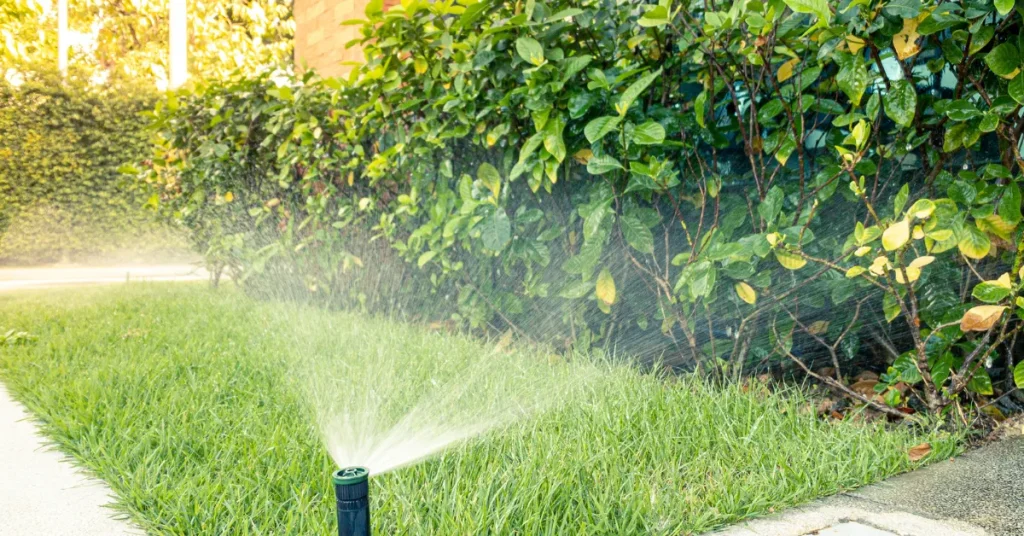Sprinkler lines are typically buried 8 to 12 inches deep. This depth protects them from damage and freezing.
Ensuring your garden’s irrigation system functions optimally requires understanding the intricacies of sprinkler line installation.
Proper depth placement of these lines is crucial, as it safeguards against accidental damages, such as those from lawn aeration or other landscaping activities, and shields against harsh weather conditions.
This introductory knowledge about sprinkler systems aids homeowners and garden enthusiasts in maintaining a lush, verdant outdoor space.
A well-installed system not only provides efficient water distribution but also reduces the possibility of maintenance issues arising from poorly positioned lines.
Regular checks and adherence to appropriate installation depths will keep your irrigation system in top condition for seasons to come.

Plumbing The Depths: Ideal Sprinkler Line Placement
Getting sprinkler line placement right is key to a lush, healthy lawn. Depth matters for efficiency and safety. Let’s dive into the ideal depths for sprinkler lines.
Assessing Your Yard’s Requirements
Before digging, consider your yard’s specific needs. Soil type, lawn size, and sprinkler system design play crucial roles.
- Soil Type: Sandy soils drain fast; clay soils hold water. Adjust depths accordingly.
- Lawn Size: Larger lawns may require a more robust system.
- System Design: Different systems have unique depth requirements.
To protect from frost, a minimum depth of 6 to 8 inches is often recommended. Always check local building codes before starting.
Regional Considerations For Depth
Climate greatly influences ideal depths.
| Region | Recommended Depth |
| Cold Climates | Beyond the frost line, 12 to 18 inches |
| Mild Climates | 6 to 10 inches, avoiding shallow placement |
| Warm Climates | 6 to 8 inches |
Keep lines under the frost line in cold regions to prevent freezing. In warm climates, shallower lines work but should be properly insulated.
Digging Into Sprinkler Installation
Planning out your sprinkler system involves more than just where to place the heads. It’s important to understand the depth at which your sprinkler lines should be buried to ensure they are safe from external damage and freezing temperatures.
Let’s dig into the process of properly installing these vital lines and what you’ll need to accomplish the task.
Tools Of The Trench: What You’ll Need
Gathering the right tools is crucial for a successful sprinkler line installation. Here’s a simple list:
- Trenching shovel or a mechanical trencher for larger projects
- Measuring tape to ensure accurate depth
- Pipe cutter or a hacksaw for cutting the sprinkler lines
- Utility knife for opening bags of sand or cutting landscape fabric
The Step-by-step Trenching Guide
- Mark the trench line: Use flags or spray paint to mark where the lines will go.
- Start digging: Begin at your starting point and follow your marks.
- Measure the depth: Sprinkler lines should be 8-12 inches deep to protect them.
- Place the pipe: Lay your pipes down in the trench, ensuring the depth is consistent.
- Backfill the trench: Use sand or dirt to cover the pipe and pack it down gently.
Executing these steps with attention to detail creates a strong foundation for an efficient sprinkler system. Remember that specific region and climate can affect the depth of your sprinkler lines. Always check local building codes for exact requirements.
A Closer Look At Sprinkler Line Depths

Understanding the proper depth for sprinkler lines is key to a well-functioning irrigation system. Let’s dive into the details to ensure your lawn’s vitality.
Common Depth Recommendations
The depth of sprinkler lines can affect both their efficiency and durability. Experts commonly recommend that they should be buried 8 to 12 inches below the surface.
This range provides protection against lawn maintenance activities, such as aeration, and climatic conditions, like frost.
- Residential areas: 8 to 12 inches
- Areas with heavy foot traffic: 12+ inches
- Light use areas: 6 to 8 inches
Factors Influencing Depth Variation
Different scenarios call for adjustments in sprinkler line installation:
| Factor | Depth Adjustment |
| Soil Type | Clay soils may require shallower lines; sandy soils, deeper lines for stability. |
| Climate | Areas with frost need deeper lines to prevent freezing. |
| Lawn Traffic | High-traffic areas must have deeper lines to avoid damage. |
| Local Regulations | Some regions have specific depth requirements for safety and efficiency. |
Consulting local guidelines and considering the unique aspects of your garden will ensure optimal installation.
Avoiding Common Installation Pitfalls
When installing sprinkler lines, accuracy is key. A simple mistake can lead to big problems, like water waste or system failure.
To create an efficient sprinkler setup, knowing the depth is not enough. It is vital to sidestep common errors. This guide helps you dodge these installation slip-ups.
Navigating Around Utilities
Underground utilities are like hidden challenges in your yard. You must know where they lie. Hitting a utility line can cause outages. It can also be dangerous. Use these steps to stay safe and respect utility lines:
- Contact 811 before you dig. This is the national call-before-you-dig number.
- Wait for the utility companies. They will mark the locations of underground lines.
- Plan your sprinkler layout with these marks in mind.
Weatherproofing Your Sprinkler System
Extreme weather can harm sprinkler lines. Your system needs protection. Here are key steps for weatherproofing:
- Choose durable materials that can withstand temperature changes.
- Install lines deep enough to avoid freezing. Typically, 6 to 12 inches is enough.
- Burying them too shallow can lead to cracks. This happens when the ground freezes.
- Seal all exposed components. Avoid water seepage and corrosion.
Following these guidelines avoids costly repairs. It keeps your sprinkler system healthy for years to come. Remember the depth, navigate with care, and shield against the elements.
Maintenance And Troubleshooting
Buried out of sight, sprinkler lines demand attention for a lush lawn. Proper maintenance prevents costly repairs. Let’s dive into routine checks and ways to address underground issues for your sprinkler system.
Routine Checks For Sprinkler Line Health
Regular inspections keep sprinkler systems running efficiently. Practice these steps:
- Monitor water pressure – Low pressure might signal a leak.
- Check for damp spots – Soft, wet areas may indicate a break.
- Examine sprinkler heads – Clean and adjust to avoid blockages.
Inspect seasonally, especially before winter to avoid freeze damage.
Addressing Leaks And Breaks Below The Surface
Spot a soggy area? You might have a leak. Follow these tips:
- Turn off the system and inspect for visible signs of damage.
- Listen for hissing sounds to locate hidden leaks.
- Use a hand trowel to gently dig around the suspected area.
For breaks, cut out the damaged piece and replace it with a new section. Always double-check connections to ensure they’re secure.
The Future Of Sprinkler Systems

The world of landscaping is bracing for a revolution. Sprinkler systems are no longer just about watering grass.
They now embody cutting-edge technology geared towards sustainable practice and convenience. Let’s explore what the future holds for these essential irrigation systems.
Advancements In Sprinkler Technology
New sprinkler systems are smart. They come with features that save time and water. They can sense the weather. They know when it’s going to rain. You don’t have to worry about switching them off.
- Wi-Fi Connectivity: Control your system from anywhere.
- Sensors Galore: Soil moisture and weather sensors adjust watering.
- App Control: Use your phone to manage watering schedules.
Environmentally Conscious Irrigation Practices
Water is precious. New sprinkler systems know this. They are designed to use less water. They help preserve the environment. The best part? They keep your lawn looking green.
| Feature | Benefit |
| Drip Irrigation | Uses water wisely, directly to roots. |
| Smart Scheduling | Water plants only when they need it. |
| Low Flow Heads | Reduce water use. Save money. Win-win. |
FAQs About How Deep Are Sprinkler Lines
What Is The Standard Depth For Sprinkler Lines?
Sprinkler lines are typically buried 8 to 12 inches deep. The depth can vary based on factors such as the type of soil and climate conditions. This depth provides protection from external damage and frost.
Can Sprinkler Lines Be Too Deep?
Yes, excessively deep sprinkler lines reduce efficiency. They can lead to increased pressure loss and potential system damage. It’s crucial to follow local guidelines to ensure optimal functionality and longevity of the system.
How Does Climate Affect Sprinkler Line Depth?
Climate plays a significant role in determining sprinkler line depth. In regions with freezing temperatures, lines must be below the frost line to prevent freezing and bursting. Warmer climates allow for shallower installations.
Are Deeper Sprinkler Lines More Protected?
Deeper sprinkler lines are less susceptible to accidental damage from activities like aeration and gardening. However, they should still follow the recommended depth to maintain system efficiency and prevent unnecessary complexity during repairs.
Conclusion
Understanding the depth of your sprinkler lines is crucial for maintenance and repairs. Typically, lines are buried 8-12 inches below the surface.
Ensuring proper burial depth safeguards them from damage and weather. Remember, always verify local guidelines before digging or installation.
Keeping your sprinklers at the right depth promotes longevity and efficiency in your watering system.
Resources:
1. https://www.usgs.gov/special-topics/water-science-school/science/irrigation-spray-or-sprinkler-irrigation
